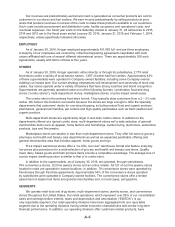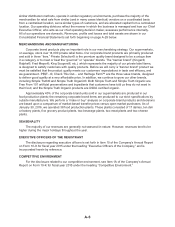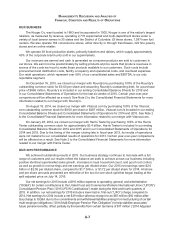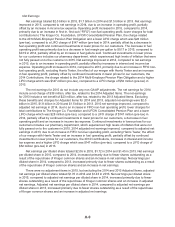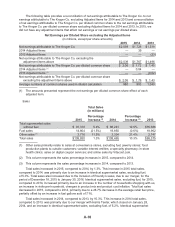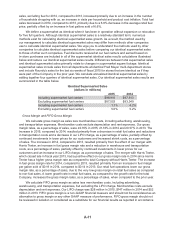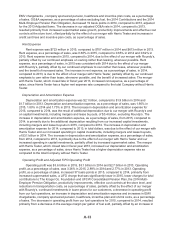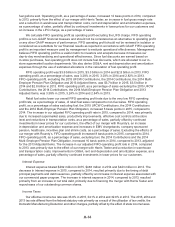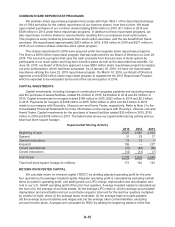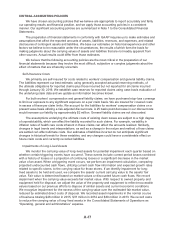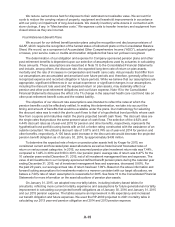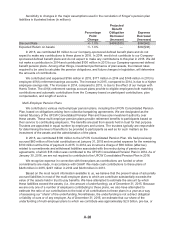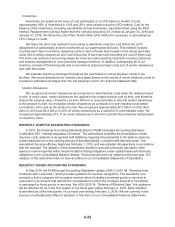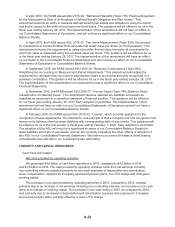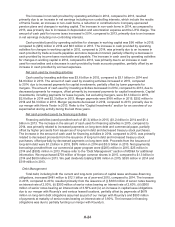Kroger 2015 Annual Report Download - page 88
Download and view the complete annual report
Please find page 88 of the 2015 Kroger annual report below. You can navigate through the pages in the report by either clicking on the pages listed below, or by using the keyword search tool below to find specific information within the annual report.A-14
fuel gallons sold. Operating profit, as a percentage of sales, increased 12 basis points in 2014, compared
to 2013, primarily from the effect of our merger with Harris Teeter, an increase in fuel gross margin rate
and a reduction in warehouse and transportation costs, rent and depreciation and amortization expenses,
as a percentage of sales, partially offset by continued investments in lower prices for our customers and
an increase in the LIFO charge, as a percentage of sales.
We calculate FIFO operating profit as operating profit excluding the LIFO charge. FIFO operating
profit is a non-GAAP financial measure and should not be considered as an alternative to operating profit
or any other GAAP measure of performance. FIFO operating profit should not be reviewed in isolation or
considered as a substitute for our financial results as reported in accordance with GAAP. FIFO operating
profit is an important measure used by management to evaluate operational effectiveness. Management
believes FIFO operating profit is a useful metric to investors and analysts because it measures our
day-to-day merchandising and operational effectiveness. Since fuel discounts are earned based on
in-store purchases, fuel operating profit does not include fuel discounts, which are allocated to our in-
store supermarket location departments. We also derive OG&A, rent and depreciation and amortization
expenses through the use of estimated allocations in the calculation of fuel operating profit.
FIFO operating profit was $3.6 billion in 2015, $3.3 billion in 2014 and $2.8 billion in 2013. FIFO
operating profit, as a percentage of sales, was 3.28% in 2015, 3.03% in 2014 and 2.82% in 2013.
FIFO operating profit, excluding the 2015 UFCW Contributions, the 2014 Contributions, the 2014 Multi-
Employer Pension Plan Obligation and 2013 Adjusted Items, was $3.7 billion in 2015, $3.5 billion in
2014 and $2.8 billion in 2013. FIFO operating profit, as a percentage of sales excluding the 2015 UFCW
Contributions, the 2014 Contributions, the 2014 Multi-Employer Pension Plan Obligation and 2013
Adjusted Items, was 3.38% in 2015, 3.24% in 2014 and 2.84% in 2013.
Retail fuel sales lower our overall FIFO operating profit rate due to the very low FIFO operating
profit rate, as a percentage of sales, of retail fuel sales compared to non-fuel sales. FIFO operating
profit, as a percentage of sales excluding fuel, the 2015 UFCW Contributions, the 2014 Contributions
and the 2014 Multi-Employer Pension Plan Obligation, increased 5 basis points in 2015, compared to
2014. The increase in our adjusted FIFO operating profit rate in 2015, compared to 2014, was primarily
due to increased supermarket sales, productivity improvements, effective cost controls at the store
level and reductions in transportation costs, as a percentage of sales, partially offset by continued
investments in lower prices for our customers, the effect of our merger with Roundy’s, an increase
in depreciation and amortization expense and increases in EMV chargebacks, company sponsored
pension, healthcare, incentive plan and shrink costs, as a percentage of sales. Excluding the effects of
our merger with Roundy’s, FIFO operating profit increased 8 basis points in 2015, compared to 2014.
FIFO operating profit, as a percentage of sales, excluding fuel, the 2014 Contributions and the 2014
Multi-Employer Pension Plan Obligation, increased 10 basis points in 2014, compared to 2013, adjusted
for the 2013 Adjusted Items. The increase in our adjusted FIFO operating profit rate in 2014, compared
to 2013, was primarily due to the effect of our merger with Harris Teeter and a reduction in warehouse
and transportation costs, improvements in OG&A, rent and depreciation and amortization expense, as a
percentage of sales, partially offset by continued investments in lower prices for our customers.
Interest Expense
Interest expense totaled $482 million in 2015, $488 million in 2014 and $443 million in 2013. The
decrease in interest expense in 2015, compared to 2014, resulted primarily due to the timing of debt
principal payments and debt issuances, partially offset by an increase in interest expense associated with
our commercial paper program. The increase in interest expense in 2014, compared to 2013, resulted
primarily from an increase in net total debt, primarily due to financing the merger with Harris Teeter and
repurchases of our outstanding common shares.
Income Taxes
Our effective income tax rate was 33.8% in 2015, 34.1% in 2014 and 32.9% in 2013. The 2015, 2014 and
2013 tax rate differed from the federal statutory rate primarily as a result of the utilization of tax credits, the
Domestic Manufacturing Deduction and other changes, partially offset by the effect of state income taxes.



